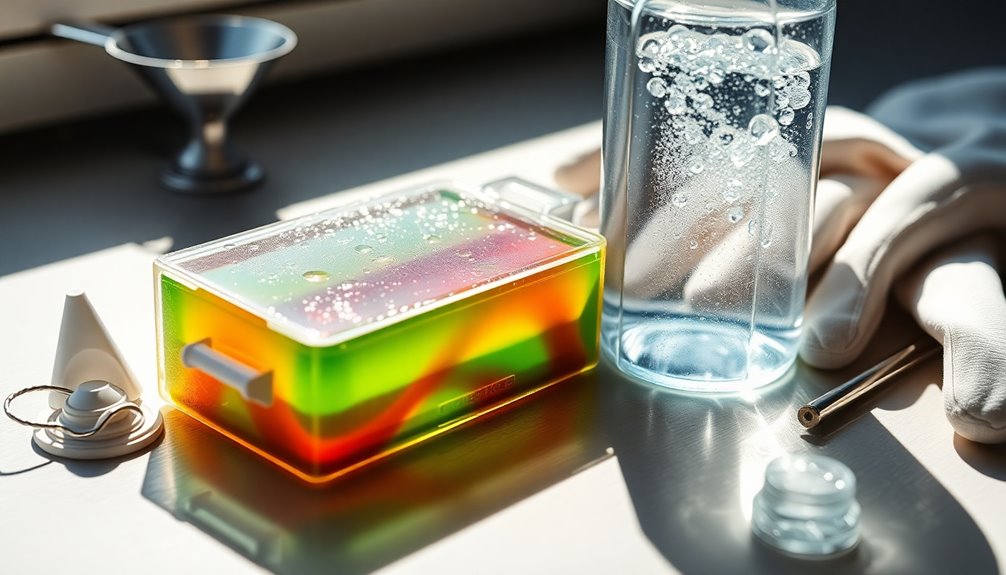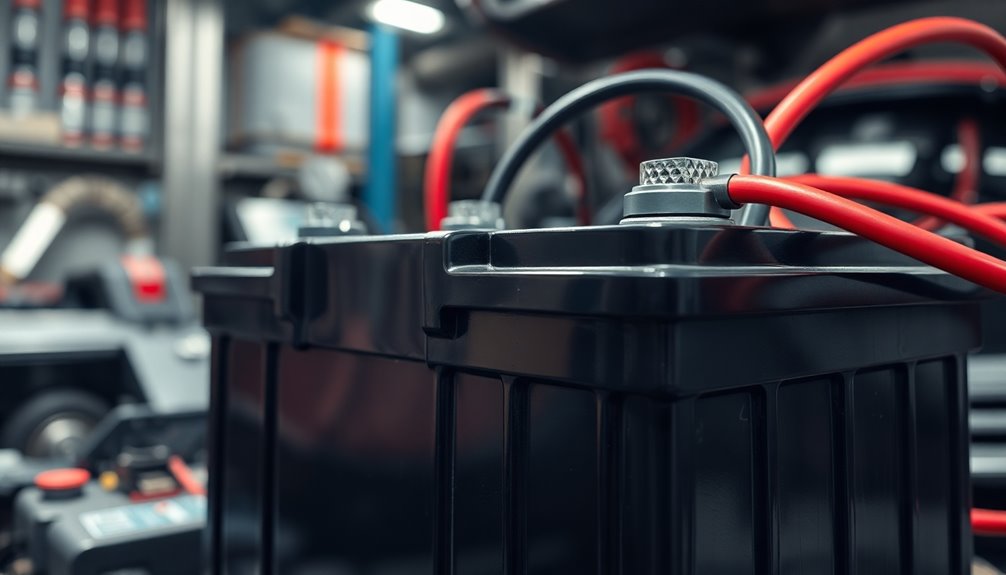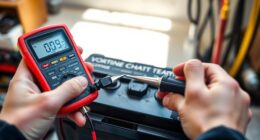Wiring batteries in series is a straightforward process that boosts your voltage. Start by connecting the negative terminal of the first battery to the positive terminal of the next. Repeat this pattern until all batteries are linked together. The final negative terminal connects to your load. Remember to use batteries with matching voltage and capacity ratings for safety. Always use a charger compatible with the total voltage of your series setup. By following these basic steps, you can enhance your power supply considerably. Stick around to uncover more tips for optimizing your battery configurations!
Key Takeaways
- Connect the negative terminal of the first battery to the positive terminal of the second to create a series connection.
- Ensure all batteries have the same voltage and capacity ratings to prevent imbalances.
- Use a charger compatible with the total voltage of the series batteries for effective charging.
- Keep safety precautions in mind to avoid short circuits during the wiring process.
- Create a wiring diagram to guide your connections and simplify assembly.
Understanding Battery Banks
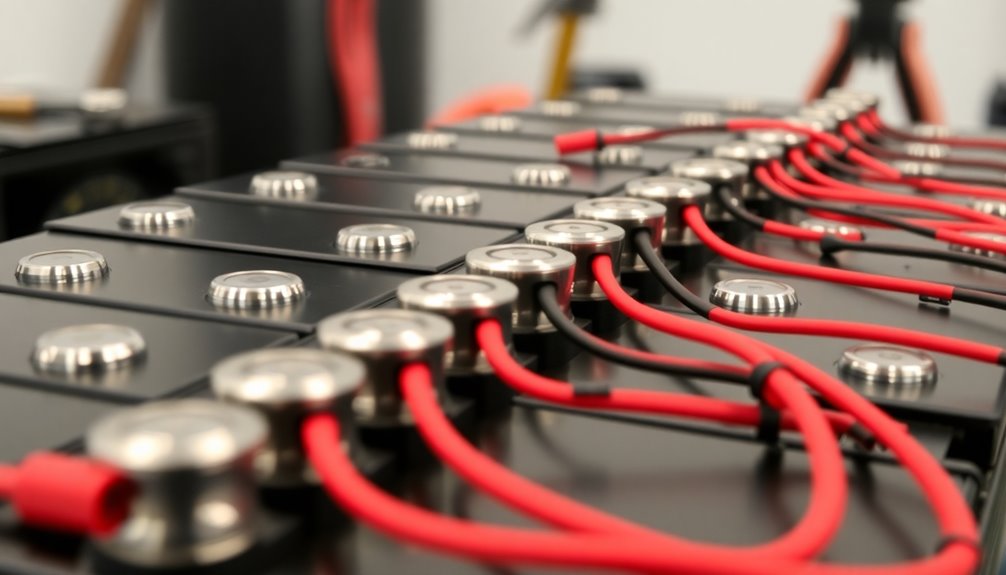
When you connect two or more batteries together, you create what's known as a battery bank, which enhances voltage, capacity, or both for your specific needs.
By configuring your battery bank in series or parallel, you can meet varying power requirements effectively.
It's crucial to choose the right battery types—common sizes like group 24, 27, and 31 are often more economical than larger options.
To guarantee peak performance and safety, always use batteries with matching voltage and capacity ratings, avoiding any mix of different battery types.
This careful selection helps maintain reliability in applications such as RVs, campers, trailers, and boats, giving you the power you need when you need it most.
Wiring Batteries in Series

Wiring batteries in series is a straightforward way to boost voltage for your battery bank while keeping the same amp-hour (AH) capacity. To create a series connection, you need to connect the negative terminal of one battery to the positive terminal of the next. This setup increases your total voltage while maintaining battery capacity.
Here are some key points to keep in mind:
- Confirm all batteries have the same voltage and capacity rating.
- Connect the positive terminal of one battery to the next.
- Connect the negative terminal of the last battery to your load.
- Use a charger that matches the total capacity of your series-connected batteries.
- Follow safety measures to prevent short circuits when wiring.
Happy wiring!
Wiring Batteries in Parallel
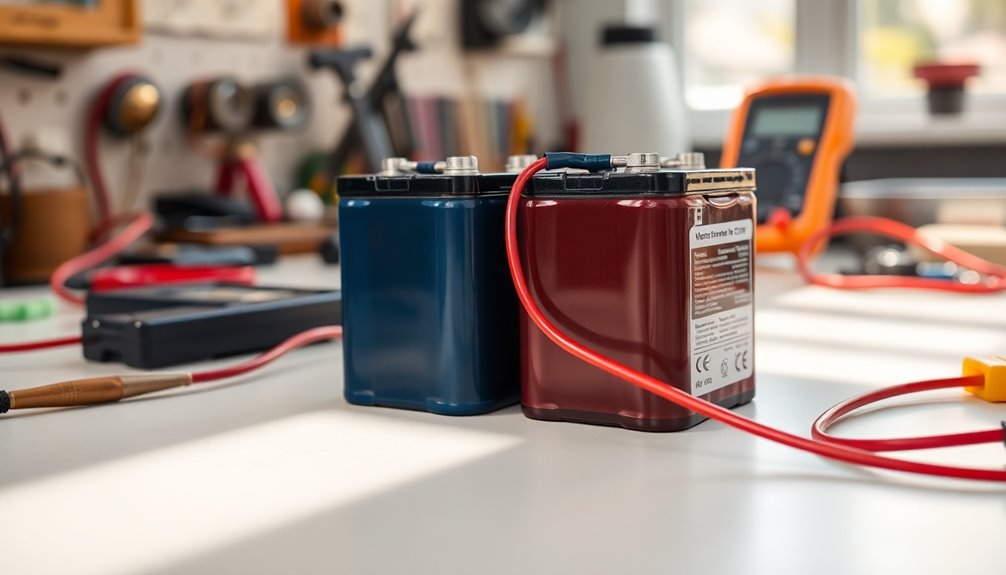
Connecting batteries in parallel is an effective method to enhance your system's amp-hour (AH) capacity while keeping the voltage steady.
When you wire batteries in parallel, you link all positive terminals together and all negative terminals using heavy-duty cables. This guarantees a secure connection and accommodates increased current, preventing overheating for safe operation.
Make certain all batteries have the same voltage rating; matching their capacity helps avoid performance issues. It's best to connect the load to opposite ends of the battery bank, promoting equal discharge across all batteries.
For instance, four 12V 100Ah batteries in parallel create a 12V system with a total capacity of 400Ah, considerably boosting your amp-hour capacity.
Series-Parallel Configuration
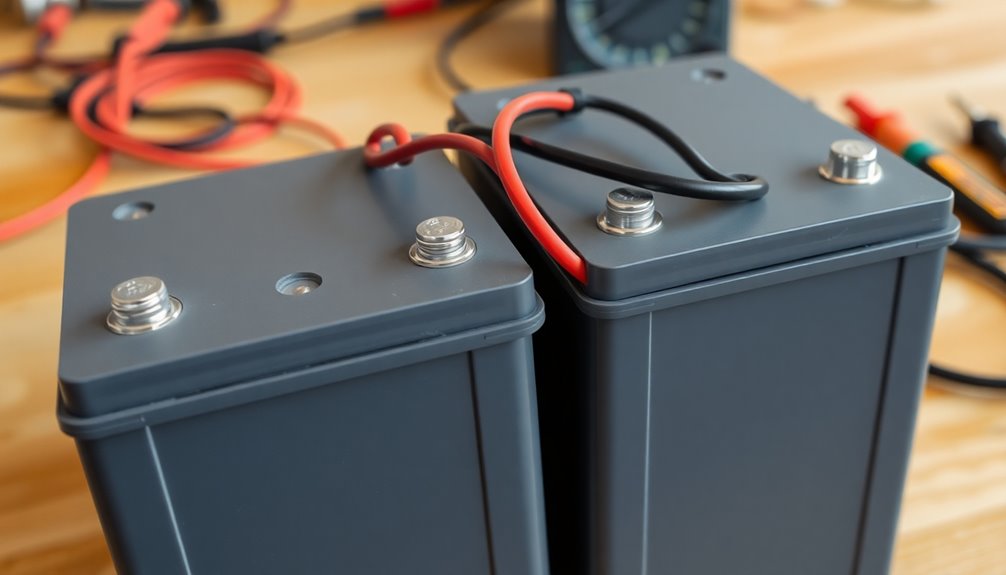
After exploring how to wire batteries in parallel, it's time to contemplate a series-parallel configuration, which offers the best of both worlds.
This setup allows you to connect two sets of batteries in series first, followed by paralleling those sets via their positive and negative terminals. By doing so, you achieve increased voltage and amp-hour capacity, making it perfect for larger power applications.
- Guarantees total output meets your needs
- Maintains battery life extension
- Provides flexibility in design
- Requires same type voltage and capacity
- Simplifies future expansions
With a series-parallel configuration, you can maximize power while keeping your system efficient and reliable.
Just remember to use batteries that match in type, voltage, and capacity!
Best Practices for Connections
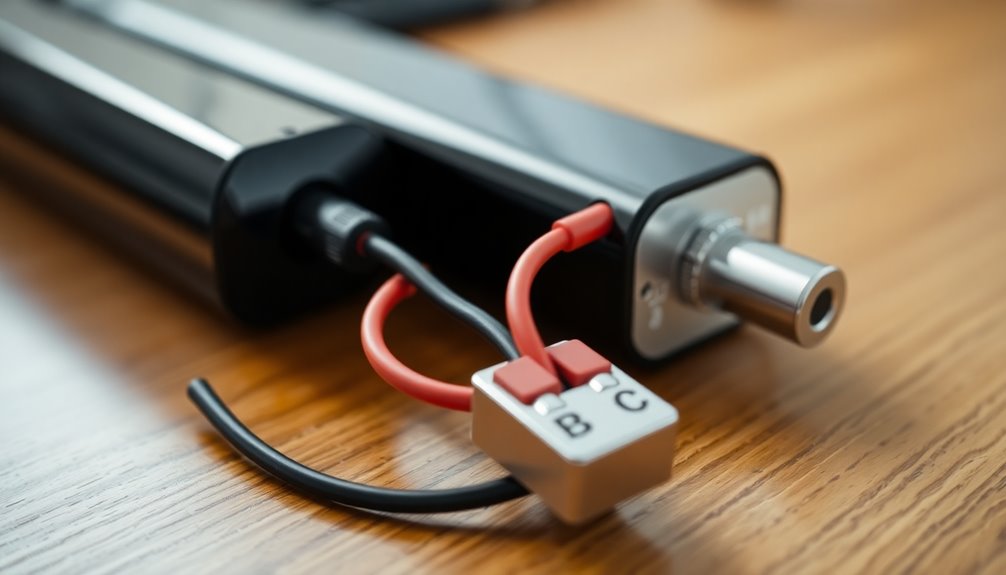
To guarantee a safe and efficient battery setup, it's crucial to follow best practices when making connections.
First, connect the negative terminal of the first battery to the positive terminal of the second battery in the series. Verify all batteries share the same voltage and capacity ratings to prevent imbalances that could lead to failures.
For peak performance, use a compatible voltage charger and consider charging each battery individually.
Before starting, create a clear wiring diagram to avoid confusion during assembly.
Finally, regularly monitor the connections for signs of corrosion or wear, as these can impact the performance and safety of your battery bank.
Keeping these practices in mind will help you achieve a reliable battery setup.
Safety Tips for Battery Handling
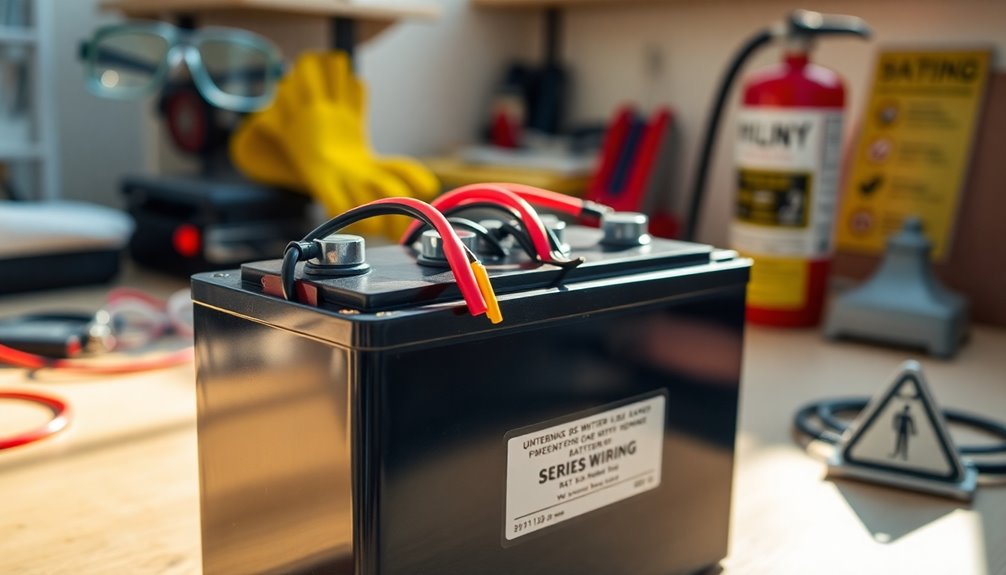
Handling batteries safely is essential to prevent accidents and guarantee longevity. By following these safety tips, you can guarantee effective battery handling while minimizing risks:
- Always wear appropriate protective gear, like gloves and goggles, to prevent injury from acid spills or electrical shock.
- Regularly inspect battery terminals and connections for corrosion, which can create safety hazards.
- Make sure all batteries in a bank share the same voltage and capacity ratings to avoid imbalances.
- Keep batteries in a well-ventilated area to prevent explosive gas buildup during charging and discharging.
- Familiarize yourself with the manufacturer's guidelines for usage, maintenance, and disposal to guarantee safe handling.
Expert Insights on Battery Wiring
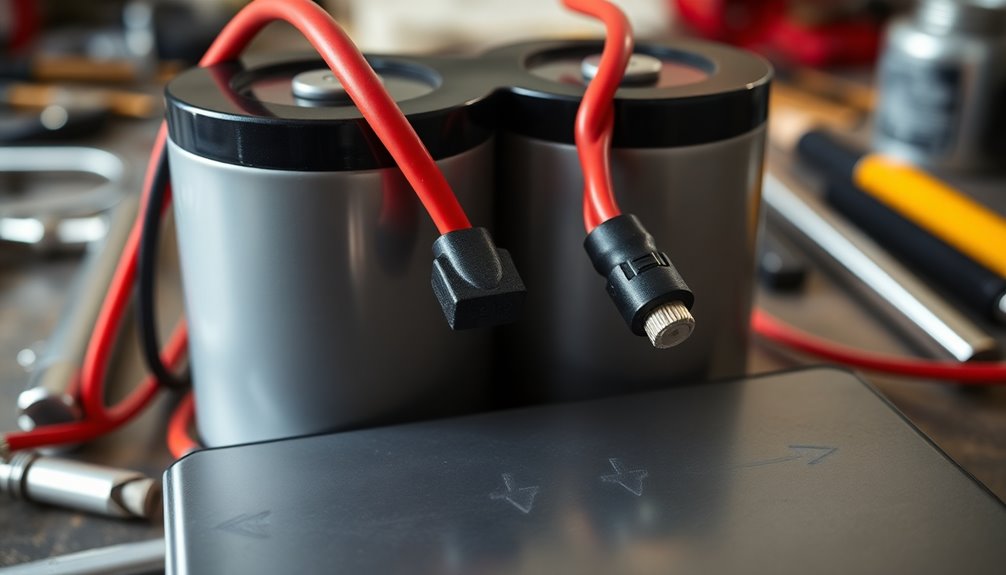
When you wire batteries in series, you can considerably increase the voltage output while keeping the amp-hour capacity the same. For example, if you connect two 12V batteries, you'll create a 24V system without changing the amp-hour rating.
To connect properly, attach the negative terminal of the first battery to the positive terminal of the second. Always verify all batteries have compatible voltage and capacity ratings.
When it comes to charging, use a charger suited for series connections, and consider charging each battery individually to prevent imbalances.
Frequently Asked Questions
How Do You Connect Batteries in Series to Increase Voltage?
To connect batteries in series and boost voltage, start by linking the negative terminal of the first battery to the positive terminal of the second battery.
Keep this pattern for any additional batteries. For instance, two 12-volt batteries wired this way will give you 24 volts.
Make sure all batteries have the same voltage and capacity to avoid imbalance.
Always use a charger compatible with the total voltage for safe charging.
How Do You Boost Batteries in Series?
You know what they say: "Two heads are better than one."
To boost your batteries in series, connect the positive terminal of one battery to the negative terminal of another. This setup increases your voltage while keeping the amp-hour capacity the same.
Confirm all batteries are the same type and voltage for peak performance.
When charging, use a compatible charger to avoid imbalances and guarantee a safe, efficient power boost.
Which Is the Correct Way to Connect Batteries in Series?
To connect batteries in series correctly, start by linking the positive terminal of the first battery to the negative terminal of the second battery.
Repeat this for additional batteries, ensuring all share the same voltage and capacity.
Always double-check that you avoid crossing terminals to prevent short circuits.
It's a good idea to sketch a wiring diagram beforehand to clarify connections and minimize mistakes, making the process smoother and safer.
How Do I Connect Two Batteries to Get More Power?
If you want to supercharge your power, connecting two batteries is like releasing a thunderstorm of energy!
To do this, you'll connect the positive terminal of the first battery to the negative terminal of the second with a jumper wire.
Make sure both batteries are identical in voltage and capacity.
Just like a perfect duet, they'll work together to double your voltage while keeping the amp-hour capacity the same.
Safety first—avoid any crossovers!
Conclusion
Wiring batteries in series can really amp up your power needs, whether you're building a battery bank for your RV or solar setup. Just remember, it's all about making the right connections and keeping safety at the forefront. With these tips, you'll be well on your way to energizing your projects. Don't let the wires get tangled; follow this guide, and you'll be in the driver's seat in no time!




